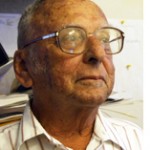Stronger Than Iron by Mendel Balberyszski; Gefen Publishing House; 331 pages; no price listed.
By Norman Manson

SAN DIEGO — In utterly excruciating detail, this memoir tells the complete story of the destruction of one of the world’s great Jewish communities – Vilna, known as “The Jerusalem of Lithuania” for at least two centuries before it was wiped out in the horrific events of World War II.
Mendel Balberyszski, a Vilna native as were his father and grandfather, wrote this narrative a few years after he managed to survive – through a combination of guile, savvy and luck – the unspeakable terror of not only Germans, but Lithuanians and even Estonians during more than three years of Nazi occupation, from June 1941 until September 1944 when the Red Army liberated the area.
And indeed it was a life fraught with desperation, with all manner of risks. There were times of hope for survival, but these would soon be dashed as “cleansings” were mercilessly carried out, taking Jews by the hundreds and thousands to their deaths in the Ponary death camp.
Most of the book is devoted to life in two ghettos established by the Nazis in September. 1941. The “small” ghettos lasted only a few weeks, but the “large” ghetto held thousands of Jews until its liquidation in September 1943. And it was ruled, under Nazi oversight, for much of that time by a Judenrat, a Jewish council whose leaders had varied attitudes, good and evil. For most of the time, the ghetto’s leader was a man named Jacob Gens, whose efforts to save the ghetto by allowing the occupiers ro conduct “cleansings” drew a measure of condemnation from Balberyszski. When Gens said “My aim is to save the ghetto,” Balberyszski replied, “You might save the ghetto but without the Jews.”
And much of the horrendous actions were the work of Lithuanians rather than Germans, and, when some, including Balberyszski, were moved to a concentration camp in Estonia, by Estonians. There were also a very few gentiles who tried to help their Jewish neighbors.
The book originally was written in Yiddish during the 1950s and published in 1967, shortly after Mendel Balberyszski’s death. His son Theodore, a boy during the Holocaust whom his father valiantly and finally successully tried to save, decided recently to translate it into English, with the help and cooperation of other family members anf fellow survivors, most now living in Australia. The translation was generally quite well done.
The book is valuable not only as a story if personal survival, under often brutal conditions, but for its in-depth account of life in the Vilna ghetto. The author pulls no punches as he writes of the varied views and actions of the Jews literally imprisoned there. Some maintained high standards of moral and ethical behavior, while other betrayed their fellow Jews as they tried any way to save themselves. In the end, virtually the entire community was wiped out.
This, then, is not a black-and-white story, and for that reason alone is a vary valuable historical document about life in Eastern Europe under Nazi occupation. While Vilna was an exceptionally large and thriving Jewish community before World War II, it probably was quite typical in its reaction to the vicious barbarism of the nazi era. This book certainly ranks as a very valuable addition to the list of Holocaust memoirs that have come to light in recent years.
*
Manson is a freelance writer based in San Diego